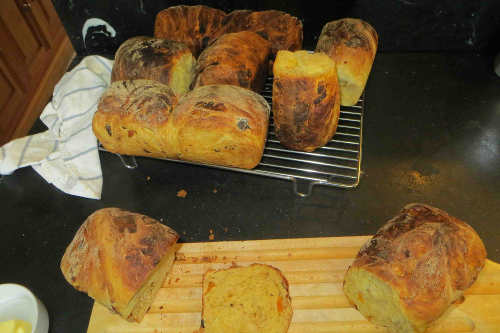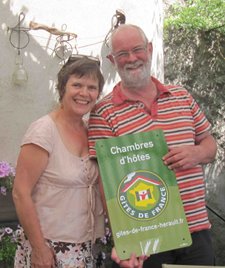An Irish Chef in France
 Euro-Toques chef Martin Dwyer, is much missed in Ireland since he and his wife Sile sold their eponymous restaurant in Waterford and moved to France. They now live in the Languedoc, where they take guests - and feed them very well.
Euro-Toques chef Martin Dwyer, is much missed in Ireland since he and his wife Sile sold their eponymous restaurant in Waterford and moved to France. They now live in the Languedoc, where they take guests - and feed them very well.
This month Martin shares his unique Pain Fruité du Presbytère
This is a case of necessity being the mother of invention.
I had a problem, especially a winter one, in that I wanted to put something with a bit of a wow factor on the Presbytère breakfast table, particularly in those months when the summer apricots and peaches had departed.
I had made classic French Brioche from time to time but it is impossibly calorific, pumped full of butter and eggs and, even though delicious, difficult to get consistently right . There is a much lighter brioche in Provence called Pompe à l’Huile, which is extremely good but not really breakfast food.
Now we have a great tradition in Ireland of adding raisins to a white soda loaf and adding in some raisins or currants the resulting loaf was called a “Curranty Bread” and treated like cake, well spread with butter, to be eaten with the cup of tea as a dessert or a snack
Sile suggested that my mother’s Curranty Bread, basically a scone mix with currants added, would be a good idea but somehow this seemed a bit too Irish - and anyway (I know this is heresy in an Irishman ) I much prefer breads risen with yeast than those using bicarbonate of soda (or its first cousin baking powder).
So I decided to try a variation of my Mother’s Fruity Loaf but base it on a yeast dough – and further more I decided to use far more and different fruit than she did. Here in France we have access to excellent Prunes from Agen (only up the road) Apricots from Greece and Dates from the north of Africa, all sound Mediterranean choices.
There was a tradition in Ireland that fruit bread and scones had very little fruit indeed, this I remember particularly on any of my (very rare) visits to a convent where the nuns would triumphantly produce their version of the height of decadence; Curranty Bread, which was so careful with the fruit that we used to call it Bicycle Cake on the basis that if you were lucky enough to find one raisin you would then need a bike to find the next one.
But I digress.
With the intention of making this bread as easy to make as possible I decided to make a sort of Fruit Fougasse, the Provençal Fougasse is an Olive Oil flatbread with (often) Olives and Anchovies in the dough, which is yeast leavened but not kneaded and so extremely easy to make.
This was not a success, the quantity of fruit I added was too heavy for the yeast to work properly and the resulting flat bread was I think more closely related to Nougat than bread, not the stuff from which memorable breakfasts are made.
Attempt the second was far more successful, I used much the same ingredients as I had for the Fougasse but this time I followed the directions for making the Provençal Pompe à l’Huile.
This is a hell of a bread, sweet (but without sugar), light, and interesting. The oil keeps it very moist without being at all fatty and the dough (for those of you old enough) is a fairly good imitation of the stuff in the original Bewley’s Cherry Buns. Great Stuff.
Here is the final recipe. I have given enough for ten small loves because it freezes perfectly
Pain Fruité for Ten Small Loaves
120g fresh yeast (or five 15g sachets of dried yeast)
550ml warm water 18cl olive oil
5 eggs
2 teaspoons salt
grated zest of 2 oranges
1500g strong flour 100g candied orange peel (chopped)
100g prunes (halved)
100g dates (stoned and halved)
100g dried apricots (halved)
100g sultanas
Dissolve the yeast into some of the measured water.
Put this somewhere warm and, when completely liquid and frothy, top up to the desired amount of water with more warm water.
Add in the olive oil, and beat in the eggs.
Grate the orange zest into the flour and add in the salt.
Now add in the yeast mixture and then blend together roughly with your hand. Add in all the fruit and knead roughly together in the bowl until it comes together in a ball.
Tip it out on a floured top and knead for five minutes.
Weigh the dough and then divide by ten (should be about 3 ¼ Kgs giving 10 x 325g)
Knead together each of these ten pieces into balls and put two each into five well oiled 1kg loaf tins.
Cover with a tea towel and leave to rise for another hour or so - they should rise well over the top of the tins.
Set the oven to 190º C, 375º F, Gas 5 and cook at this temperature for about 40 minutes.
Slip the loaf out of the tin and cook for another 10 minutes at the same temperature.
Break each loaf in two as you take it from the tin and let them cool on a wire rack.
Have this for breakfast (or dinner or tea), with or without butter or jam. It will freeze beautifully and toast well (but watch the pieces of fruit which can char in the toaster).
-------------
 Martin Dwyer started cooking professionally over 40 years ago in the legendary “Snaffles Restaurant” in Dublin. After a time in a Relais Chateau in Anjou and in “The Wife of Bath” in Kent he opened his own much acclaimed restaurant, “Dwyers”, in Waterford in 1989. In 2004 he sold this and moved south to France where he and his wife Síle bought and restored an old presbytery in a village in the Languedoc. They now run Le Presbytère as a French style Chambre d’Hôte. Martin however is far too passionate about food to give up cooking so they now enjoy serving dinner to their customers on the terrace of Le Presbytère on warm summer evenings. Martin runs occasional cookery courses in Le Presbytère and Síle’s brother Colm does week long Nature Strolls discovering the Flora and Fauna of the Languedoc.
Martin Dwyer started cooking professionally over 40 years ago in the legendary “Snaffles Restaurant” in Dublin. After a time in a Relais Chateau in Anjou and in “The Wife of Bath” in Kent he opened his own much acclaimed restaurant, “Dwyers”, in Waterford in 1989. In 2004 he sold this and moved south to France where he and his wife Síle bought and restored an old presbytery in a village in the Languedoc. They now run Le Presbytère as a French style Chambre d’Hôte. Martin however is far too passionate about food to give up cooking so they now enjoy serving dinner to their customers on the terrace of Le Presbytère on warm summer evenings. Martin runs occasional cookery courses in Le Presbytère and Síle’s brother Colm does week long Nature Strolls discovering the Flora and Fauna of the Languedoc.
Le Presbytère can be seen at: www.lepresbytere.net;
email: martin@lepresbytere.net
Twitter: www.twitter.com/DwyerThezan






There are currently no comments
Leave a comment
Not a member? Register for your free membership now!
Or leave a comment by logging in with: